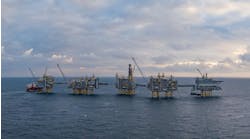Deepwater getting deeper
The US Minerals Management Service is contemplating changing its definition of deepwater from 1,000 ft to 1,500 ft. MMS Regional Director Chris Oynes called the revision "more realistic."
The MMS currently describes shallow water as up to 999 ft, deepwater as 1,000 ft to 4,999 ft, and ultra deepwater as over 5,000 ft. The change, expected to go into effect next year, parallels the standards oil companies have modified.
Oynes said the definitions had been dictated by technology in the past, evident in the fact that in the past, work beyond 1,000 ft of water required special technology.
In related MMS news, new operations rules that go into effect under the terms of Western Gulf of Mexico Lease Sale 184 will revise seismic activity levels and when operations will be able to ramp-up in water depths exceeding 200 m. Survey operations will now halt if a sperm whale is found within a 180-db impact zone. The change restricts ramp-up to daytime operations, when a geophysical company would be able to see a sperm whale in the 180-db area. Ramp-up is achieved by a progressive buildup of energy output from a single airgun to the desired intensity of the airgun arrays. The number of guns fired simultaneously from the array increases to the ramp-up level. In water depths from 708 m to 6,310 m, the 180-db area could range from 0.2 mi to 3.9 mi. The ramp-up period allows sea turtles and sperm whales to depart areas of seismic activity before the decibel level becomes harmful or harassing to these species.
International Association of Geophysical Contractors President G.C. Gill has asked the National Oceanic and Atmospheric Administra-tion Fisheries to reconsider certain points in its biological opinion. In a letter, Gill asked Fisheries Assistant Administrator William Hogarth to rescind the opinion to allow for correction and reconsideration of terms and conditions. The IAGC letter said, "The scientific deficiencies that we have identified ellipse are, we believe, serious enough that once they are corrected, fundamentally different mitigation measures than those imposed by the Sale 184 stipulations will be called for."
One point the IAGC raises is that there seems to be little overlap in common airgun frequencies and the hearing sensitivity of sperm whales. "Given that the acoustic frequencies generated by airgun arrays do not significantly overlap the sensitive hearing and vocalization frequency ranges of sperm whales, the IAGC would submit that the (180 db) restriction is over restrictive," the IAGC said.
Scientists are studying why sperm whales, like these two, have homed in on the Mississippi Canyon portion of the GoM. Research suggests the area might be a breeding ground for sperm whales. Photo by Jonathan Gordon, Sperm Whale Seismic Study
Oynes said the government and industry have been working together to find solutions to issues arising from the lease sale notice.
Another provision included in Sale 184 includes the requirement that operators report sightings and locations of dead and injured endangered and threatened species, such as sea turtles and sperm whales. Oynes said the MMS is designing a training program to help operators fulfill this obligation, which will not require new personnel be added to a vessel.
Sale 184, which included provisions carried over from other lease sales about royalty relief for deepwater operations and breaks for deep gas for new leases, does not include a measure for pre-existing leases. The MMS is working on a rulemaking to address applying relief to blocks already under lease, Oynes said.
"We hear everybody loud and clear on that," he said.
Neptune up for more appraisal drilling
Neptune partners plan further appraisal work in the Atwater Valley block 617 field in deepwater Gulf of Mexico after finding pay and better flow quality in the Neptune-3 appraisal well.
The BHP Billiton-operated field is in 6,140 ft water depth. Partners BHP, Marathon Oil Co., and Woodside Petroleum said the Neptune-3 appraisal well, drilled to 18,643 ft MD, encountered 450 gross ft of hydrocarbon column, with 130 ft of net oil pay in a similar Miocene age reservoir as seen in Neptune-1, drilled in 1995, and Neptune-2, drilled in 1998. An additional 20 ft of net oil pay was also encountered in a younger Miocene age reservoir. Neptune-3 data showed that the field's oil has better flow characteristics than indicated by Neptune-2, Woodside said.
These flow properties, said Steve Bell, BHP deepwater discovery and appraisal president, offer "the potential for development, but we will need to evaluate all the data and carry out further appraisal activity in order to fully assess the commercial potential of the accumulation."
Neptune lies in the Atwater Foldbelt along a trend from the Mad Dog and Atlantis fields under development in the GoM.
The C.R. Luigs drilled Neptune-3, which was temporarily abandoned while partners determine a location for the next appraisal well. Appraisal activity is expected by the end of the year, Marathon said. Pending further appraisal results, development options under consideration are a tieback to a future production hub in the area or a stand-alone production facility, BHP said.
Devils Tower in 2Q 2003
Dominion Exploration and Production and Pioneer Natural Resources Co. said the Devils Tower project is nearing its onstream production target of 2Q 2003. Five development wells were drilled for the Devils Tower project in the deepwater Gulf of Mexico.
Dominion CEO Duane Radtke put field reserves at 80-150 MMboe. The Spar is more than 50% complete. The project will allow up to 60,000 b/d production from the discovery in Mississippi Canyon block 773. The Devils Tower spar will have eight dry tree producing wells. The five development wells were drilled from the future Spar location and will be completed as producers. The Devils Tower discovery well and two of the appraisal wells announced previously will also be completed as producers.
First production is expected by the end of 2Q 2003, for discovery to first production in less than 42 months.
Dominion E&P also announced the discovered Triton as a future 3-mi subsea tie-back to the Devils Tower Spar floating production system. Triton discovery well No. 4 in Mississippi Canyon block 772 encountered a total of 80 ft of net true vertical thickness pay in two intervals. One to three wells will be required to produce the expected reserves of 10 to 40 MMboe.
Operator Dominion E&P holds 75% interest in Devils Tower and Triton, and Pioneer holds 25% interest.




